|
|
Created/dedicated as per personal communication with Wayne Yang, August 21, 2019
Updated as per James P. Tuttle's The Hawk Moths of North America, August 21, 2019
Updated as per BAMONA, August 21, 2019
|
Sphingidae Larval Checklist
Alpine County, California, and Nearby Counties:
El Dorado; Amador; Calaveras; Toulumne
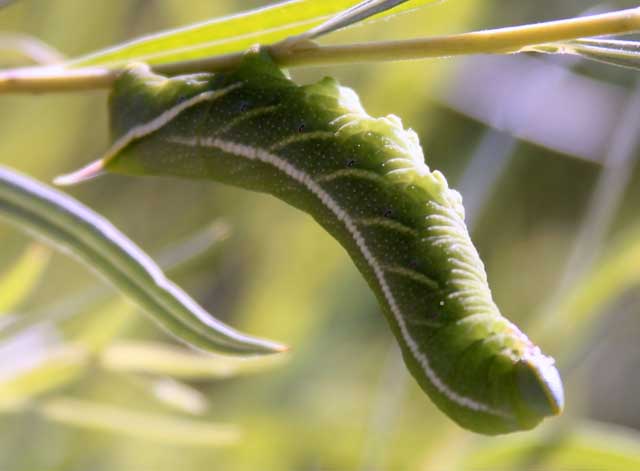
Smerinthus cerisyi fifth instar, Indian Creek Campground, Markleeville, Alpine County, California,
August 21, 2019, courtesy of Wayne Yang; possibly Smerinthus ophthalmica.
For care of "found larvae/caterpillars" visit Manduca sexta larva, central Texas,
August 21, 2008, Trina Woodall.
This page is inspired by and dedicated to Wayne Yang, who provides the image of Smerinthus cerisyi
at top of this page. Wayne sent the photo asking for some identification help, and I am going first with cerisyi, based on reddish tint to anal horn,
but it could also be Smerinthus ophthalmica.
Thirty-three Sphingidae species are listed on the BAMONA website for California. Not all of the species are reported by BAMONA for Alpine.
(Seven species: Sphinx vashti; Sphinx asellus; Sphinx drupiferarum; Sphinx perelegans, Pachysphinx occidentalis,
Hemaris thetis, Hyles lineata, are listed by BAMONA for Alpine County) as of August 21, 2019.
A green Alpine indicates the moth is reported on the BAMONA website (Alpine County) and/or in Moths of Western
North America, #2. Distribution of Sphingidae of Western North America, revised, an excellent little booklet available through Paul Opler.
Please help me develop this list with improved, documented accuracy by sending sightings (species, date, location), preferably with an
image, via email to Bill Oehlke.
Please also forward sightings to BAMONA, an excellent online resource.
Although this page was originally designed to cover Alpine County, it is also valid for the following counties:
Alpine: Sphinx asellus; Sphinx drupiferarum; Sphinx perelegans; Sphinx vashti; Pachysphinx occidentalis; Hemaris thetis; Hyles lineata;
Amador: Manduca sexta; Sphinx perelegans; Smerinthus cerisyi; Hemaris thetis; Eumorpha achemon; Proserpinus clarkiae; Proserpinus lucidus;
Calaveras: Sphinx chersis; Sphinx perelegans; Sphinx sequoiae; Hemaris thetis; Proserpinus clarkiae;
El Dorado: Sphinx perelegans; Sphinx sequoiae; Sphinx vashti; Smerinthus cerisyi; Hemaris thetis; Eumorpha achemon;
Proserpinus clarkiae;
Toulumne: Manduca quinquemaculatus; Sphinx chersis; Sphinx perelegans; Sphinx sequoiae; Sphinx vashti; Paonias myops; Smerinthus cerisyi;
Eumorpha achemon; Hyles lineata; Proserpinus lucidus; Proserpinus clarkiae.
Visit Alpine County Sphingidae Adult Sphinx Moths; Hawkmoths.
Visit California Catocala: Underwing Moths.
If you are travelling, you can find active Sphingidae checklists for all countries in North, Central, and South America and the Caribbbean via the links at
North, Central, South American Sphingidae checklists
Sphinginae subfamily
Sphingini tribe:

|
Manduca quinquemaculatus
WO/Toulumne,
the Five-spotted Hawkmoth
The caterpillars are called Tomato Hornworms and each has a black horn at the end of the abdomen.
Larvae feed on potato, tobacco, tomato, and other plants in the
nightshade family (Solanaceae). There is also a very beautiful brown form. See bottom of page.
|
 |
Manduca sexta
WO/Amador/, the Carolina Sphinx
Tobacco Hornworms, equipped with a red-tipped horn at the end of the
abdomen, are true gluttons and feed on tobacco and tomato, and
occasionally potato and pepper crops and other plants in the
nightshade family (Solanaceae).
|
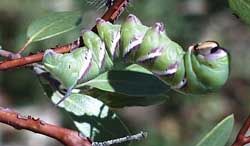 |
Sphinx asellus, Alpine, Asella sphinx:
Larval hosts are Manzanita and Arctostaphylos of the Ericaceae family. Look for a blue horn and strong purple colouration.
This one is probably rare in northcentral California.
|
 |
Sphinx chersis
WO/Calaveras/Toulumne, the Great Ash Sphinx.
The larvae are pale bluish green. The head has a pair of yellow
lateral bands meeting at the apex.
Larval hosts are ash, lilac, privet, cherry, and quaking aspen.
|
 |
Larvae hide in the day and feed primarily on cherry, plum, and apple
at night. Larvae have been found on Amelanchier nantuckensis
in Massachusetts and have been reared to pupation in Michigan on
Prunus serotina. Note purple oblique lines.
|
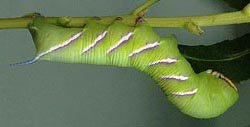 |
Sphinx perelegans
Alpine/Amador/Calaveras/El Dorado/Toulumne, the Elegant Sphinx;
A unique feature of this larva is a shield on the first thoracic
segment, which is of the same colour as the body and which forms a
tight-fitting hood over the vertex of the head. This hides a pair of
glossy black spots on top of the head, which are revealed if the
animal is disturbed.
|
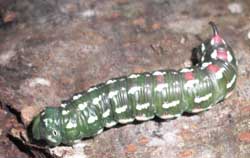 |
Sphinx sequoiae
WO/Calaveras/El Dorado/Toulumne, the
Sequoiae Sphinx:
Larvae feed on California juniper (Juniperus californica) and Rocky Mountain juniper (J. osteosperma).
(generally more westerly)
|
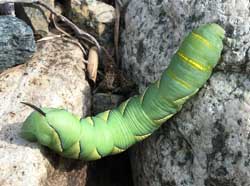 |
Sphinx vashti
Alpine/El Dorado/Toulumne, the Snowberry Sphinx
Larvae feed on the common snowberry (Symphoricarpos albus)
and on coralberry (S. orbiculatus). Note the two golden
lines of slightly raised bumps, one just behind the head, the other
on the thorax.
|
Smerinthini Tribe:
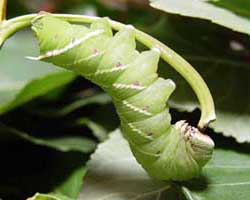 |
Larvae feed on cottonwood and poplar (Populus) and willow
(Salix).
Larvae are very chunky with little to distinguish them
from Pachysphinx modesta.
|
 |
Larvae accept willows, birches, and cherries.
I have also found them in the wild on oak in eastern Canada.
Skin is quite granulous. (generally more northerly)
|
 |
Paonias myops
WO/Toulumne, the Small-eyed Sphinx
Wild cherry species are the favorites as larval foodplants, but eggs
will also be deposited on birches and other forest trees.
There are varying degrees in the amount of red markings along the sides.
|
 |
Smerinthus cerisyi
WO/WY/Amador/El Dorado/Toulumne,
Cerisy's Sphinx;
Cerisyi larvae greatly resemble modesta larvae, both being pale
green, with granular skin, pale lateral diagonal lines, faint red
spiracular circles, and very pale longitudinal lines running from the
head to a more pronounced anal diagonal line.
Larvae have green heads bounded dorsally with a pale yellow
inverted "V".
|
Smerinthus cerisyi, Indian Creek Campground, Markleeville, Alpine County, August 21, 2019, Wayne Yang
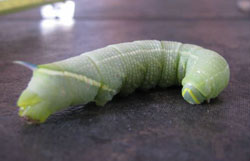 |
Smerinthus ophthalmica
WO (just as likely as cerisyi):
Ophthalmica larvae resemble cerisyi larvae, both being pale
green, with granular skin, pale lateral diagonal lines, faint red
spiracular circles, and very pale longitudinal lines running from
head to more pronounced anal diagonal line.
Larvae have green heads bounded dorsally with pale yellow
inverted "V". Note blue horn.
|
Macroglossinae subfamily
Dilophonotini Tribe:
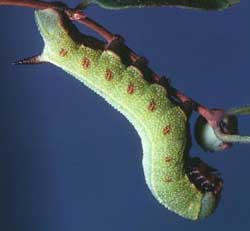 |
Hemaris thetis
Alpine/Amador/Calaveras/El Dorado.
Larval host plants include Snowberry (Symphoricarpos),
honeysuckle (Lonicera), Coralberry, viburnums, high bush cranberry and hawthorn (Crataegus).
Horn is black with a slightly lighter base. This western species was formerly classified as
H. diffinis or H. senta. Those species west of the Continental Divide are now classified as
H. thetis.
|
Philampelini Tribe:
 |
Eumorpha achemon
WO/Amador/El Dorado/Toulumne,
the Achemon Sphinx:
Larvae feed upon Grape (Vitis), Virginia Creeper
(Parthenocissus quinquefolia) and other vines and ivies
(Ampelopsis).
Larvae occur in both a light (green) form and a darker (tan/brown)
form. Note six "segmented" oblique lines, as well as absence of anal horn in final instar.
|
Macroglossini Tribe:
 |
Hyles lineata
Alpine/Toulumne, the White-lined Sphinx
Larvae are highly varied and feed on a great diversity of plants
including willow weed (Epilobium), four o'clock (Mirabilis),
apple (Malus), evening primrose (Oenothera), elm
(Ulmus), grape (Vitis), tomato (Lycopersicon),
purslane (Portulaca), and Fuschia.
All larvae seem, however, to have the red/black swellings split by
dorso-lateral lines. |
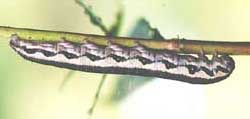 |
Proserpinus clarkiae
WO/Amador/Calaveras/El Dorado/Toulumne, Clark's Sphinx,
Larvae feed on elegant fairyfan (Clarkia unguiculata) in the evening primrose family (Onagraceae). |
|
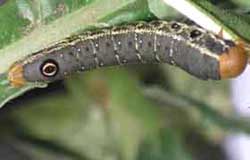 |
Proserpinus lucidus
WO/Amador/Toulumne, Pacific Green
Sphinx Moth or Bear Sphinx. Larvae feed on evening primrose
(Oenothera dentata var. campestris) and clarkias. David Wikle
fed them on both Mexican evening primrose, Oenothera berlandieri
and evening primrose, Oenothera biennis. (formerly classified as Arctonotus lucidus) |
|
Enjoy some of nature's wonderments, giant silk moth cocoons.
These cocoons are for sale winter and fall. Beautiful Saturniidae moths will emerge the following spring and summer.
Read Actias luna rearing article. Additional online help available.
Use your browser "Back" button to return to the previous page.
This page is brought to you by Bill Oehlke and the
WLSS. Pages are on space rented from Bizland. If you would like to become a "Patron of the Sphingidae Site", contact Bill.
Please send sightings/images to Bill. I will do my best to respond to requests for identification help.
 | 
Show appreciation for this site by clicking on flashing butterfly to the left.
The link will take you to a page with links to many insect sites. |




















